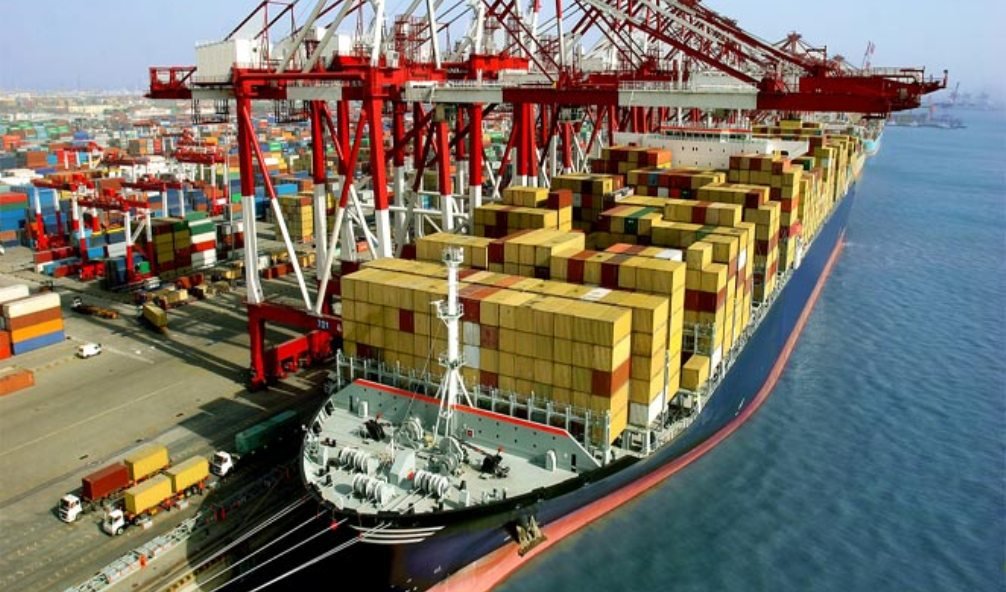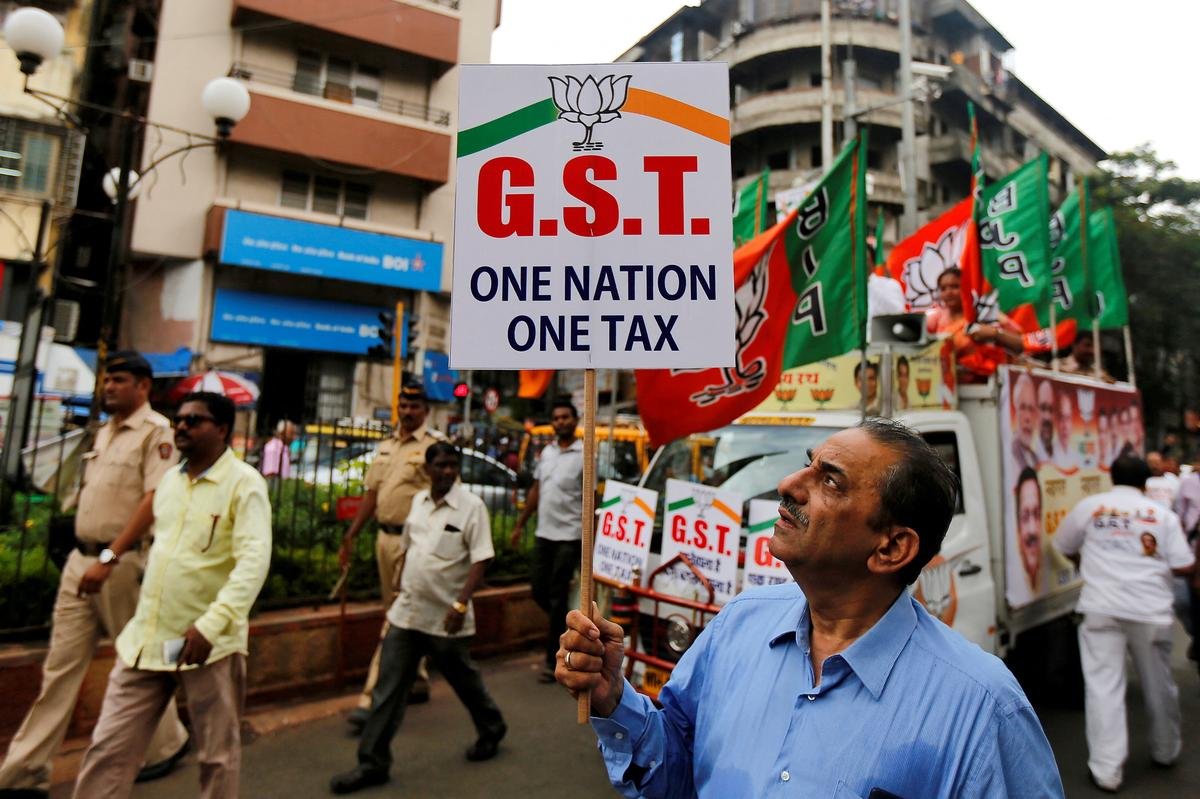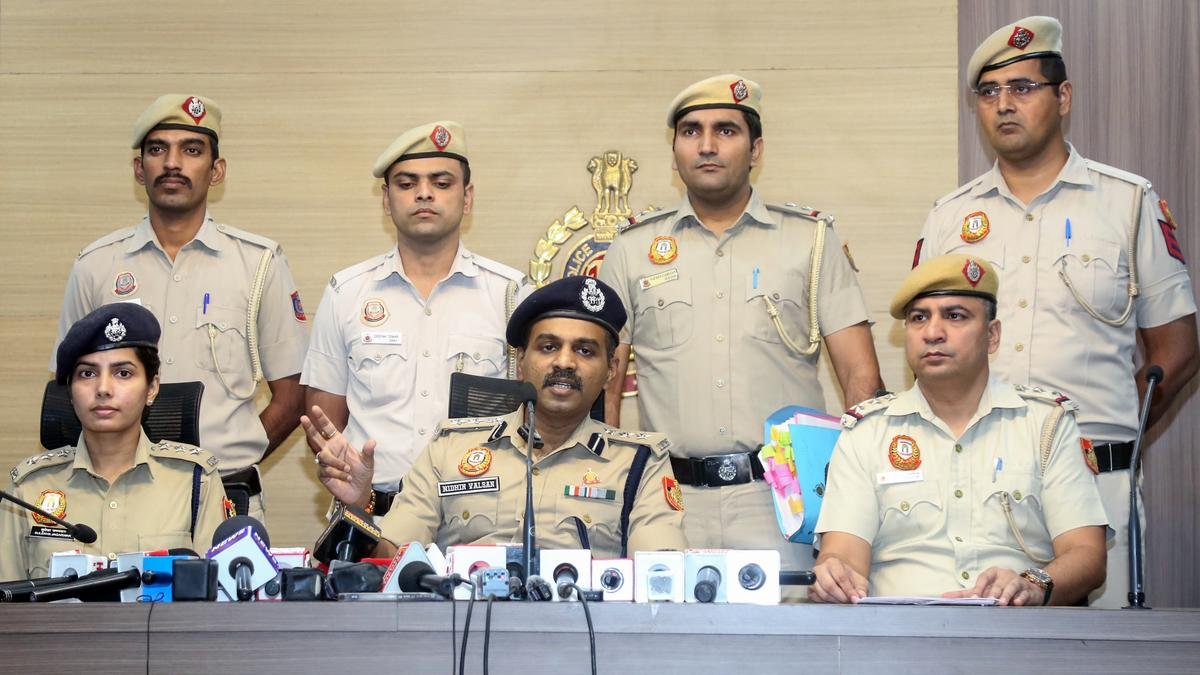Background
- Ports play a crucial role in facilitating international trade and economic development. In India, port infrastructure has been a focus of development for several decades, and the country has made significant progress in this area.
- India has a coastline of over 7,500 kilometers, and the country has 13 major ports and around 200 minor ports. The major ports are managed by the central government, while the minor ports are managed by state governments or private companies.
- The major ports in India are located in Mumbai, Chennai, Kolkata, Visakhapatnam, Kochi, Paradip, Jawaharlal Nehru Port Trust (JNPT), Kandla, Mormugao, New Mangalore, Tuticorin, Ennore, and V.O. Chidambaranar.
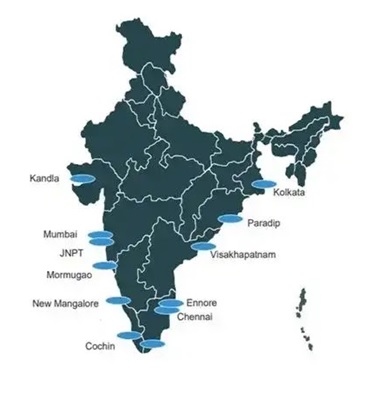
Significance of ports for Indian economy
Ports play a vital role in the economic development of a country like India. Some of the key reasons why ports are significant for the Indian economy:
- Facilitating international trade: Ports are the gateways to international trade and facilitate the movement of goods and services between countries. With a vast coastline of over 7,500 kilometers, India has several major and minor ports that handle a significant amount of international trade, including imports and exports. In FY 2020-21, the major ports in India handled 704.8 million tonnes of cargo, comprising a wide range of commodities such as coal, crude oil, iron ore, and containers. Ports play a critical role in facilitating this trade, contributing significantly to the country’s economy.
- Employment generation: Ports are significant employment generators in the country. The development of ports creates several direct and indirect job opportunities, including jobs in port operations, shipping, logistics, and ancillary industries. According to a study by the National Council of Applied Economic Research (NCAER), the port sector has the potential to create around 40 million direct and indirect jobs in India by 2025.
- Boosting economic growth: Ports are essential for the economic growth of a country. They facilitate the movement of goods and services, reduce logistics costs, and enhance connectivity, all of which contribute to the growth of businesses and industries. Ports also play a crucial role in promoting port-led industrialization, creating jobs and boosting economic development in port areas.
- Revenue generation: Ports contribute significantly to the revenue of the Indian government. The revenue generated from port operations includes port dues, berth hire charges, and other charges. The government also earns revenue from land leases and other commercial activities in and around port areas.
- Connectivity: Ports play a critical role in improving connectivity within the country and with other countries. The development of supporting infrastructure, such as road and rail connectivity, enhances the efficiency of port operations and facilitates the movement of goods and people.
- Relations with other nations: Countering China’s influence because China has actively exacerbated India’s transshipment issue with Sri Lanka through its Belt and Road Initiative. China has already leased Sri Lanka’s Hambantota port for 99 years. As a result, India’s development of ports and provision of local transshipment facilities are crucial strategic requirements.
- Integration in the region: As South Asia remains one of the least integrated regions, India’s eastern seaboard can assist in reviving an integrated hub-and-spoke model for regional connectivity in the Bay of Bengal.
- Provider of Net Security in the IOR: A lot of western nations are betting against India’s ability to compete with China in the IOR. By improving its coastal security, ensuring port modernizations, and ensuring its connectivity with the hinterland, India could hedge on their support to realize its goal of becoming a Net Security Provider in the IOR.
Performance of Indian ports
- Cargo handling: Indian ports have recorded consistent growth in cargo handling in recent years. In FY 2020-21, the major ports handled 704.8 million tonnes of cargo, registering a growth of 2.5% over the previous year. This growth was primarily driven by higher coal, container, and iron ore traffic.
- Efficiency: The efficiency of Indian ports has improved significantly in recent years. The average turnaround time (ATT) for vessels at major ports has reduced from 82 hours in 2017-18 to 64 hours in 2019-20. Similarly, the average pre-berthing detention (PBD) time has reduced from 26 hours to 20 hours during the same period. The reduction in ATT and PBD time has improved the overall efficiency of ports and reduced logistics costs for shippers.
- Capacity utilization: Capacity utilization at Indian ports has improved in recent years, driven by infrastructure development and modernization. The average capacity utilization at major ports increased from 67% in 2016-17 to 72% in 2019-20.
- Container traffic: Container traffic at Indian ports has been growing at a steady pace in recent years. In FY 2020-21, the major ports handled 17.5 million TEUs (twenty-foot equivalent units) of containers, registering a growth of 3.7% over the previous year.
- Port-led industrialization: Indian ports have been successful in promoting port-led industrialization, which has created jobs and boosted economic development in port areas. Several major ports have set up industrial clusters and SEZs in and around port areas, attracting investment and generating employment.
Ports led development cases
- Singapore: Because of its natural deep-sea ports and its position at the crossroads of important shipping routes, Singapore’s trade is a major economic sector, along with services and production.
- China: The Liner Shipping Connectivity Index (LSCI) shows that a number of China’s container ports are among the world’s most connected.
- UK: It is estimated that the ports industry was directly responsible for 57% of GVA, 52% of employment, and 61% of turnover in 2017.
Models of port development
- The service port model: is superior to the landlord port model. The land and all of the available assets—both fixed and mobile—are owned by the port authority, which also handles all port and regulatory duties.
- The port landlord model: Private businesses manage port operations, primarily cargo handling, while the publicly governed port authority serves as a landlord and a regulator. The infrastructure is leased to private businesses, who provide and maintain their own superstructure and install their own equipment to handle cargo. The port authority retains ownership of the port here.
Problems facing the Indian ports sector:
- Congestion: According to a report by the Ministry of Shipping, congestion is a significant problem at major ports in India, with an average turnaround time of 62 hours for vessels in FY 2020-21. This is much higher than the global average of 24-36 hours. The report also notes that the high volume of cargo handled by these ports, combined with limited capacity and infrastructure, has led to significant delays and increased logistics costs.
- Infrastructure: Despite significant investment in port infrastructure development, many Indian ports still lack adequate capacity and infrastructure. According to a report by the National Transport Development Policy Committee, the capacity utilization of major ports in India was around 65% in 2019, indicating that there is still significant scope for improvement. Poor road and rail connectivity to and from ports further adds to the infrastructure-related challenges facing the sector.
- Land acquisition: The acquisition of land for port infrastructure development is often met with opposition from local communities and environmental activists, leading to delays and cost overruns. According to a report by the Parliamentary Standing Committee on Transport, Tourism, and Culture, land acquisition for port development in India has been a significant challenge, leading to delays in several projects.
- Policy and regulatory framework: The policy and regulatory framework governing the ports sector in India is complex and fragmented, leading to delays, confusion, and increased costs. According to a report by the World Bank, the lack of a unified regulatory body and overlapping jurisdictions among different agencies has led to regulatory uncertainty, hindering the development of the sector.
- Technology adoption: The ports sector in India has been slow to adopt new technologies and digital solutions. According to a report by the Confederation of Indian Industry, only a few Indian ports have adopted advanced technologies such as automated container handling systems and smart port solutions. The lack of automation and digitalization of port operations affects the efficiency and competitiveness of Indian ports in the global market.
- Limited Links to the Hinterland: Poor hinterland connectivity via rail, road, highways, coastal shipping, and inland waterways causes inefficiency. This thusly builds the expense of transportation and freight development.
- Effect on the environment
Poor adherence to environmental regulations causes spills and leaks from cargo loading and unloading, as well as oil spill pollution, to occur frequently in ports. Marine ecosystems are in danger from the water released during ship cleaning and ballast water discharge. Digging creates natural issues (expanded sedimentation) influencing neighborhood efficiency of the nearby waters and its fisheries.

Measures to improve the functioning of ports in India
- Capacity expansion: One of the key ways to improve the functioning of ports in India would be to invest in capacity expansion. This could involve expanding existing ports or building new ones to cater to the growing demand for cargo handling. This would require significant investment in infrastructure, including berths, handling equipment, and dredging.
- Automation and digitalization: The adoption of advanced technologies such as automation and digitalization could significantly improve the efficiency and competitiveness of Indian ports. Automation could reduce the reliance on manual labor and increase productivity, while digitalization could improve supply chain visibility and reduce logistics costs.
- Improving connectivity: Improving road and rail connectivity to and from ports would significantly improve the movement of goods, reducing delays and logistics costs. This would require investment in infrastructure such as road and rail networks, as well as the development of multimodal transport solutions.
- Land acquisition: Land acquisition for port development has been a significant challenge in India. Streamlining the land acquisition process and addressing the concerns of local communities and environmental activists could help reduce delays and cost overruns.
- Policy and regulatory framework: Improving the policy and regulatory framework governing the ports sector in India could help reduce regulatory uncertainty and improve the investment climate. This could involve the creation of a unified regulatory body for the sector, simplifying the approval processes, and reducing bureaucratic red tape.
- Public-private partnerships: Encouraging public-private partnerships (PPPs) could help leverage private sector expertise and investment in the ports sector. PPPs could involve the private sector taking on the responsibility for port operations and management, while the government provides the necessary infrastructure and regulatory framework.
Inland waterways in India
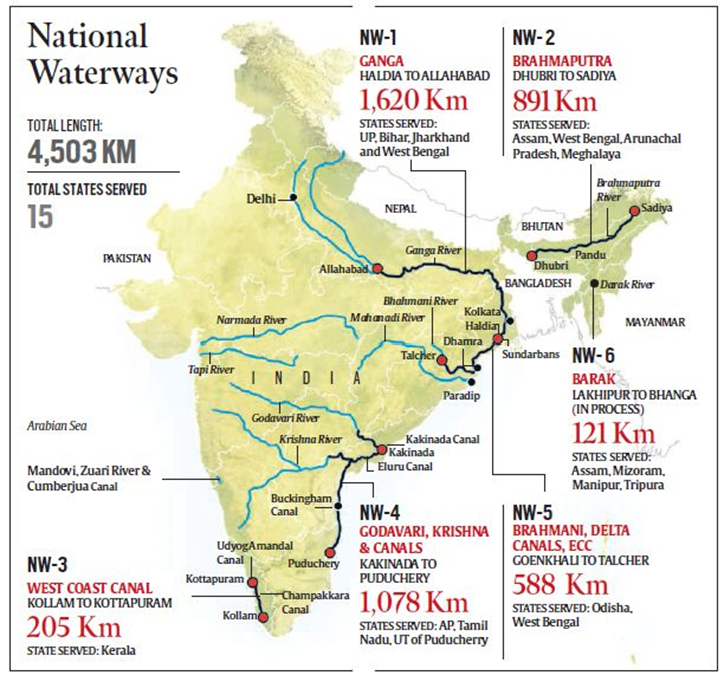
India has an extensive network of rivers and canals, which have the potential to serve as a cost-effective mode of transportation for bulk goods. Here are some key facts and figures about inland waterways in India:
- National Waterways: India has declared 111 rivers across the country as National Waterways. These waterways are classified based on their potential for development and include the Ganga-Bhagirathi-Hooghly river system, Brahmaputra river, West Coast Canal, and many others.
- Length of Waterways: India has approximately 20,000 km of navigable inland waterways. However, only a small fraction of this length is currently being used for transportation.
- Advantages of Inland Waterways: Inland waterways transportation has several advantages over road and rail transportation, including lower transportation costs, reduced carbon emissions, and fewer accidents. Inland waterways can also provide access to remote areas that are not easily accessible by road or rail.
- Multi-Modal Terminals: The government of India is developing multi-modal terminals on the national waterways to promote the use of inland waterways for transportation. These terminals provide seamless connectivity between inland waterways, highways, and railways, and help to reduce the logistics cost of transportation.
- Cargo Movement: Inland waterways are primarily used for the transportation of bulk goods such as coal, fertilizers, and cement. Inland waterways can handle large volumes of cargo and provide a reliable mode of transportation.
Key developments related to inland waterways development in India:
- National Waterway Act: The National Waterway Act was passed in 2016, which declared 111 rivers across the country as national waterways. This allowed for the development of waterways as a means of transportation and opened up opportunities for private sector investment.
- Development of National Waterways: The government of India is developing several national waterways across the country, including the Ganga-Bhagirathi-Hooghly river system, Brahmaputra river, and West Coast Canal. The development of these waterways includes the construction of jetties, terminals, and dredging of water channels to improve navigability.
- Multi-Modal Terminals: The government of India is developing multi-modal terminals on the national waterways to promote the use of inland waterways for transportation. These terminals will provide seamless connectivity between inland waterways, highways, and railways, and will reduce the logistics cost of transportation.
- Inland Waterways Authority of India (IWAI): The IWAI is the nodal agency responsible for the development and regulation of inland waterways in India. The IWAI is implementing several projects for the development of national waterways, including the construction of jetties, terminals, and navigational aids.
- Public-Private Partnerships: The government of India is encouraging public-private partnerships (PPPs) in the development of inland waterways. PPPs are being used for the development of multi-modal terminals, construction of new vessels, and dredging of water channels.
- Eco-Friendly Transport: Inland waterways transport is an eco-friendly mode of transport that reduces carbon emissions and pollution. The government of India is promoting inland waterways transport to reduce road congestion and pollution caused by road transportation.
Problems with inland waterways in India:
- Low Utilization: The utilization of inland waterways in India is currently very low, primarily due to inadequate infrastructure, lack of modern vessels, and limited navigational aids. As a result, the potential benefits of inland waterways transportation are not fully realized.
- Limited Connectivity: Inland waterways in India are not well connected to major industrial centers and transportation hubs, which limits their use for cargo movement. The lack of seamless connectivity between inland waterways, highways, and railways is a significant challenge.
- Drought and Flooding: India is prone to both drought and flooding, which can significantly impact the navigability of inland waterways. During droughts, water levels in rivers and canals may drop, making navigation difficult or impossible. During floods, water levels may rise rapidly, causing damage to infrastructure and disrupting navigation.
- Lack of Private Investment: Private sector investment in inland waterways development is limited due to the high cost of infrastructure development, lack of clear policy guidelines, and regulatory barriers. The lack of private investment makes it difficult to develop inland waterways infrastructure and create a sustainable transportation system.
- Environmental Concerns: Inland waterways development can have significant environmental impacts, including habitat destruction, water pollution, and disruption of natural water flows. These concerns must be addressed through sustainable development practices and environmental management.
Steps taken by government
- Sagarmala Programme: The Sagarmala Programme is a flagship initiative of the government of India to promote port-led development in the country. The programme aims to develop infrastructure for transportation along India’s 7,500 km coastline, including port modernization and connectivity, coastal economic zones, and coastal community development.
- The Project Jal Marg Vikas (JMVP): It is a project to improve India’s national waterways. It was put into action as a step toward national integration with the goals of minimizing resource depletion, reducing carbon emissions, and alleviating congestion on the roads and rails.
- Fund for the Central Road and Infrastructure: A list of projects and infrastructure sub-sectors, including inland waterways, for which the CRF could be used has been added by the Ministry of Finance to the Central Road Fund Act of 2000. Since then, the Central Road and Infrastructure Fund now goes by the CRF name.
- Draft Indian Ports Bill 2021: aims to bring the management of minor ports, which are currently handled by state governments, under one roof.
- The Inland Vessels Act: The bill aims to include a single national law rather than a variety of state-specific regulations. State approvals will not be required, and the registration certificate will be valid nationwide. It also creates a single database for recording information about the vessel and crew on an Internet portal.
- Marine aids to navigation Bill 2021: It was approved by the Parliament, taking into account India’s international obligations in this area, technological advancements, and global best practices.
Conclusion
Improving the functioning of ports in India would require a multi-pronged approach, involving significant investment in infrastructure, adoption of advanced technologies, improving connectivity, streamlining land acquisition processes, improving the policy and regulatory framework, and encouraging public-private partnerships.
Addressing these challenges would be critical to improving the efficiency and competitiveness of Indian ports and supporting the country’s economic development.


